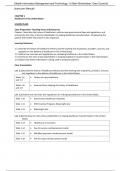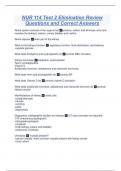(Health Information Management and Technology, 1e Beth Shanholtzer, Gary Ozanich)
(Instructor Manual)
CHAPTER 1
Healthcare in the United States
LESSON PLANS
Class Preparation: Teaching Focus and Resources
Chapter 1 describes the history of healthcare, outlines new governmental laws and regulations, and
summarizes the roles of the key stakeholders in shaping healthcare transformation. Empowering the
patient with health information is also explained.
Learning Outcomes
1.1 Describe the history of healthcare delivery and the evolving role of patients, providers, insurers, and
regulators in the delivery of healthcare in the United States.
1.2 Outline how new laws and regulations are reshaping healthcare in the United States.
1.3 Summarize the roles of key stakeholders in shaping healthcare transformation in the United States.
1.4 Explain how health information is being used to empower patients.
Class Presentation
L.O. 1.1 Describe the history of healthcare delivery and the evolving role of patients, providers, insurers,
and regulators in the delivery of healthcare in the United States.
Slides 1-6 • History of early healthcare
and 1-7
Slides 1-8 • External forces shaping the history of healthcare
and 1-9
L.O. 1.2 Outline how new laws and regulations are reshaping healthcare in the United States.
Slide 1-10 • Government healthcare initiatives
Slide 1-11 • EHR Incentive Program, Meaningful Use
Slide 1-12 • Meaningful Use
L.O. 1.3 Summarize the roles of key stakeholders in shaping healthcare transformation in the United
States.
Slide 1-13 • Healthcare in transition
Slide 1-14 • Fee-for-service reimbursement model
Slide 1-15 • Modified payments reimbursement model
Slide 1-16 • Fee-for-value reimbursement model
Copyright © 2016 McGraw-Hill Education. All rights reserved. No reproduction or distribution without
the prior written consent of McGraw-Hill Education.
, Shanholtzer 1e, Instructors’ Manual
Chapter 1
L.O. 1.4 Explain how health information is being used to empower patients.
Slide 1-17 • Health information empowering the patient
Slide 1-18 • Focal areas of healthcare in the US
Summary Slides
Slide 1-19 • Synopsis of the chapter
Teaching Tips
- Ensure students understand the key terms—suggest flash cards, Jeopardy game, etc.
- Have students research the beginning of Medicare and Medicaid.
- Discuss the differences between the Medicare and Medicaid EHR Incentive Programs.
- Visit the CMS website (www.CMS.gov) and list requirements and examples of each Meaningful
Use stage.
- Have students select one type of Physician Specialist and research the requirements beyond
that needed to become a medical doctor.
- Discuss the necessity for greater specificity in reporting healthcare data.
- Compare and contrast the fee-for-service, modified payments, and fee-for-value reimbursement
models.
- Have students create their own personal health records using one of the many free software
applications found on the internet.
- Research one specific mHealth device and discuss the features and benefits of the product.
- Complete the Thinking it Through exercises as the text is covered.
- Assign chapter review questions to be completed as a homework assignment or during class
time.
- Chapter test questions are available in Connect.
ANSWER KEYS
Thinking it Through ANSWER KEY
LO 1.1:
1. Question: Why has there been increased oversight and regulation in the healthcare industry
since the early part of the 20th century?
Answer: As the cost of providing health and medical care increased due to new advances in
medicine, expensive technology, salaries, and the like, Medicare, Medicaid, and other third-
party insurers could no longer pay whatever the amount billed without ensuring that the care
was medically necessary and reasonable. Fraud and abuse also increased as well. Thus, the
increase in federal, state, and third-party payer regulation and oversight was the result.
Learning Outcome: 01.01
Feedback: Increased healthcare costs caused insurers to be unable to pay for care without
ensuring it was necessary and reasonable; this caused fraud and abuse to increase.
Consequently, increased oversight was needed to control this.
Copyright © 2016 McGraw-Hill Education. All rights reserved. No reproduction or distribution without
the prior written consent of McGraw-Hill Education.
, Shanholtzer 1e, Instructors’ Manual
Chapter 1
2. Question: During the 20th century, there was a shift from inpatient care with long lengths of
stay to ambulatory care, which remains the principal method of care today. Why is that?
Answer: Ambulatory care remains a viable option because it reduces the need for long-terms
stays and provides more convenience for the patient in the form of walk-in clinics and
freestanding surgical facilities.
Learning Outcome: 01.01
Feedback: Ambulatory care remains prevalent today because of the convenient, less-intensive
nature of treatment.
3. Question: Why are Medicare and Medicaid so important in shaping healthcare?
Answer: Answers may vary, but students should discuss the intent of both pieces of legislation
to lift America out of the Great Depression and how their associated costs and details caused a
number of other laws and regulations to be enacted.
Learning Outcome: 01.01
Feedback: Medicare and Medicaid helped to lift America out of the Great Depression, but their
associated costs and repercussions caused many other pieces of legislation to be enacted as
well.
4. Question: Brainstorm with another student or in a group what is meant by “informed” consent.
Answer: Answers may vary, but students should mention that informed consent is provided in
“patient terms” and that it outlines the potential risks, benefits, and alternatives to certain
(risky) procedures.
Learning Outcome: 01.01
Feedback: Informed consent means, basically, that a patient is aware of the risks, benefits, and
alternatives to certain procedures that have been explained in lay terms.
LO 1.2:
1. Question: How do the Affordable Care Act and HITECH work together?
Answer: HITECH aims to increase the use of EHRs, data reporting, and data analysis; these
endeavors help to ensure that the changes mandated by the ACA will happen.
Learning Outcome: 01.02
Feedback: The main goals of HITECH – especially increasing the use of EHRs and data reporting –
make the changes required by the ACA possible.
2. Question: What are the “carrot” and “stick” components of Meaningful Use? Do you think they
will achieve what they are designed to do?
Answer: The “carrot” of MU is the incentives available to facilities that adopt EHRs; the “stick” is
a reduction in Medicare reimbursements. Yes/no section should be accepted as long as
sufficient explanation is given.
Learning Outcome: 01.02
Feedback: Meaningful Use provides a carrot (incentive payments to purchase and use EHRs) and
a stick (reductions in Medicare reimbursements) in order to motivate providers and hospitals.
3. Question: How can technology, such as the EHR, help providers obtain more complete health
information that will lead to providing better care to their patients?
Copyright © 2016 McGraw-Hill Education. All rights reserved. No reproduction or distribution without
the prior written consent of McGraw-Hill Education.
, Shanholtzer 1e, Instructors’ Manual
Chapter 1
Answer: Specifics may vary, but technology allows providers to compile more accurate and
complete health information about their patients and assists with improving coordination of
care. It gives the patient the ability to view their health record and to access communication
with their provider.
Learning Outcome: 01.02
Feedback: EHRs provide quick access to patient records for all care providers and enable better
control and management of chronic illnesses, seeing successful results of treatments and
wellness plans. When the information is in patients' hands more quickly, this motivates them to
take control of their own health, in some cases providing information to their physicians, again
achieving better results for the patient.
4. Question: Why do the three stages of Meaningful Use need to be rolled out in this order?
Answer: The ultimate goal of Meaningful Use is to improve outcomes. This cannot be done if
Stage 1 – beginning to gather and report data – and Stage 2 – using that data to advance clinical
procedures – do not happen in the outlined order. It all starts with data gathering.
Learning Outcome: 01.02
Feedback: Basically, healthcare outcomes cannot be improved (Stage 3) if data gathering and
sharing (Stage 1) does not lead to advancing clinical procedures (Stage 2).
LO 1.3:
1. Question: Identify the stakeholders in healthcare and how their role is being changed by
healthcare transformation.
Answer: The stakeholders in healthcare are HHS, Medicare and Medicaid, insurance companies,
employers, and public health organizations. All these stakeholders are being changed by the
new priority of gathering and using data. The governmental organizations have more “evidence”
to back up legislations, insurance companies have clearer pictures of codes and billing practices,
employers have more incentive to offer wellness and preventative care coverage for employees,
and public health agencies are better able to see trends and problems in the population at large.
Learning Outcome: 01.03
Feedback: The stakeholders in healthcare are HHS, Medicare and Medicaid, insurance
companies, employers, and public health organizations. Each entity is being positively impacted
by the growing amount of evidence and data available to them as they legislate, approve
coverage, provide coverage for employees, and work to improve population health.
2. Question: What are the advantages of an integrated delivery network?
Answer: Answers may vary, but students should discuss the benefit of having all healthcare
coordinated and tracked under one “umbrella” of the IDN.
Learning Outcome: 01.03
Feedback: An integrated delivery network is beneficial for, among other things, the ability for a
patient to have his care coordinated and streamlined under one “umbrella” – the IDN.
3. Question: How will the implementation of ICD-10-CM/PCS improve healthcare data?
Answer: The ICD-10 conversion will improve healthcare due to the increased specificity in
coding and the ability to expand the code set as new diseases and procedures emerge.
Learning Outcome: 01.03
Feedback: ICD-10 captures far more specificity and was designed to allow for code expansion as
the need for new diseases, new procedures, and even greater specificity emerges.
Copyright © 2016 McGraw-Hill Education. All rights reserved. No reproduction or distribution without
the prior written consent of McGraw-Hill Education.





